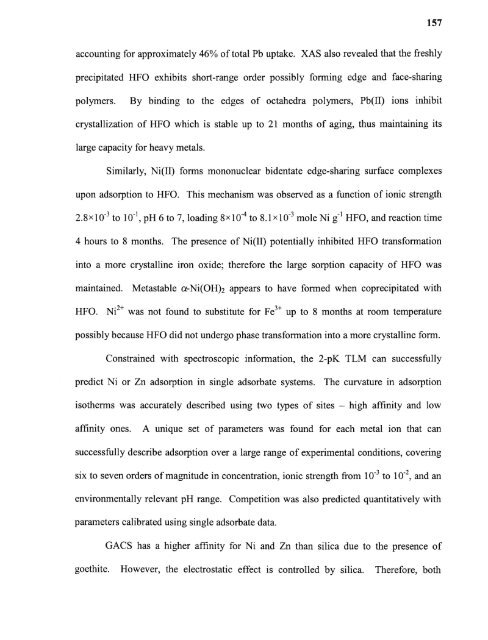Heavy metal adsorption on iron oxide and iron oxide-coated silica ...
Heavy metal adsorption on iron oxide and iron oxide-coated silica ...
Heavy metal adsorption on iron oxide and iron oxide-coated silica ...
Create successful ePaper yourself
Turn your PDF publications into a flip-book with our unique Google optimized e-Paper software.
157accounting for approximately 46% of total Pb uptake. XAS also revealed that the freshlyprecipitated HFO exhibits short-range order possibly forming edge <strong>and</strong> face-sharingpolymers. By binding to the edges of octahedra polymers, Pb(II) i<strong>on</strong>s inhibitcrystallizati<strong>on</strong> of HFO which is stable up to 21 m<strong>on</strong>ths of aging, thus maintaining itslarge capacity for heavy <str<strong>on</strong>g>metal</str<strong>on</strong>g>s.Similarly, Ni(II) forms m<strong>on</strong><strong>on</strong>uclear bidentate edge-sharing surface complexesup<strong>on</strong> <str<strong>on</strong>g>adsorpti<strong>on</strong></str<strong>on</strong>g> to HFO. This mechanism was observed as a functi<strong>on</strong> of i<strong>on</strong>ic strength2.8x10-3 to 10-1 , pH 6 to 7, loading 8 x10 -4 to 8.1x10-3 mole Ni g-1 HFO, <strong>and</strong> reacti<strong>on</strong> time4 hours to 8 m<strong>on</strong>ths. The presence of Ni(II) potentially inhibited HFO transformati<strong>on</strong>into a more crystalline ir<strong>on</strong> <strong>oxide</strong>; therefore the large sorpti<strong>on</strong> capacity of HFO wasmaintained. Metastable a-Ni(OH)2 appears to have formed when coprecipitated withHFO. Ni2+ was not found to substitute for Fe 3+ up to 8 m<strong>on</strong>ths at room temperaturepossibly because HFO did not undergo phase transformati<strong>on</strong> into a more crystalline form.C<strong>on</strong>strained with spectroscopic informati<strong>on</strong>, the 2-pK TLM can successfullypredict Ni or Zn <str<strong>on</strong>g>adsorpti<strong>on</strong></str<strong>on</strong>g> in single adsorbate systems. The curvature in <str<strong>on</strong>g>adsorpti<strong>on</strong></str<strong>on</strong>g>isotherms was accurately described using two types of sites — high affinity <strong>and</strong> lowaffinity <strong>on</strong>es. A unique set of parameters was found for each <str<strong>on</strong>g>metal</str<strong>on</strong>g> i<strong>on</strong> that cansuccessfully describe <str<strong>on</strong>g>adsorpti<strong>on</strong></str<strong>on</strong>g> over a large range of experimental c<strong>on</strong>diti<strong>on</strong>s, coveringsix to seven orders of magnitude in c<strong>on</strong>centrati<strong>on</strong>, i<strong>on</strong>ic strength from 10 -3 to 10-2, <strong>and</strong> anenvir<strong>on</strong>mentally relevant pH range. Competiti<strong>on</strong> was also predicted quantitatively withparameters calibrated using single adsorbate data.GACS has a higher affinity for Ni <strong>and</strong> Zn than <strong>silica</strong> due to the presence ofgoethite. However, the electrostatic effect is c<strong>on</strong>trolled by <strong>silica</strong>. Therefore, both
















